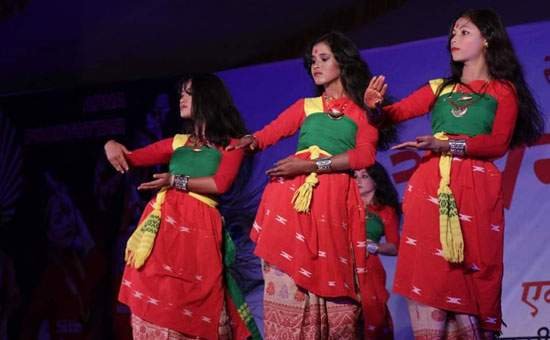In the northeastern part of India, amidst the verdant landscapes and vibrant cultures, lies Assam, a land steeped in tradition and folklore. Among the rich tapestry of its cultural heritage, one finds the Deodhani dance, a captivating ritualistic form that embodies the spirit of the region. Rooted in ancient mythology and practiced with fervor even today, the Deodhani dance holds a special place in the hearts of the Assamese people, serving as a celebration of their deep connection to nature, spirituality, and community.
Deodhani Dance of Assam
Originating from the mystical depths of Assam’s folklore, the Deodhani dance is deeply intertwined with the worship of the serpent deity, Manasa, who holds significant reverence in the region. Manasa, the goddess of snakes, is believed to bestow blessings upon her devotees, protecting them from the perils of snakebites and granting fertility and prosperity. The dance, therefore, serves as a form of invocation to appease the goddess, seeking her benevolence and protection.
The word “Deodhani” itself is derived from “Deo,” meaning God, and “Dhani,” which refers to the practitioner or priestess. Thus, a Deodhani dancer is essentially a priestess who acts as a medium between the mortal world and the divine realm during the performance of the dance. Clad in vibrant traditional attire, adorned with ornate jewelry and garlands of flowers, the Deodhani dancer exudes an aura of mystique and grace, captivating the audience with her every movement.
Central to the Deodhani dance is the depiction of various mythological narratives and rituals associated with the worship of Manasa. The performance typically begins with invocations and prayers to the goddess, accompanied by the rhythmic beats of traditional Assamese instruments like the dhol, pepa, and taal. As the music builds in intensity, the dancer enters a trance-like state, channeling the energy of the deity and embodying her divine presence.
The movements of the Deodhani dancer are characterized by fluidity and grace, with each gesture laden with symbolic meaning. Through intricate footwork, graceful hand gestures, and subtle facial expressions, the dancer narrates tales of creation, destruction, and rebirth, invoking the cosmic forces that govern the universe. The serpentine motifs, symbolic of the goddess Manasa, are prominently featured in the choreography, with the dancer often imitating the sinuous movements of a snake with mesmerizing precision.
Beyond its ritualistic significance, the Deodhani dance also serves as a form of cultural expression and community bonding in Assam. During festive occasions and religious ceremonies, the Deodhani dancers play a pivotal role in entertaining the masses and instilling a sense of collective identity and pride. Through their performances, they uphold age-old traditions and pass down ancient wisdom to future generations, ensuring the continuity of Assam’s cultural heritage.
However, despite its enduring popularity, the Deodhani dance faces challenges in the modern era. Rapid urbanization, changing social dynamics, and the onslaught of globalization pose threats to traditional art forms like Deodhani, relegating them to the margins of society. Efforts must be made to preserve and promote this invaluable cultural treasure, not only for its artistic merit but also for its role in fostering a sense of belonging and cultural cohesion among the people of Assam.
In conclusion, the Deodhani dance of Assam stands as a testament to the rich cultural legacy of the region, embodying centuries of tradition, mythology, and spiritual devotion. As the custodians of this ancient art form, it is incumbent upon the people of Assam to cherish and nurture their cultural heritage, ensuring that the mesmerizing rhythms of the Deodhani dance continue to echo through the ages, captivating hearts and minds for generations to come.











